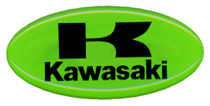
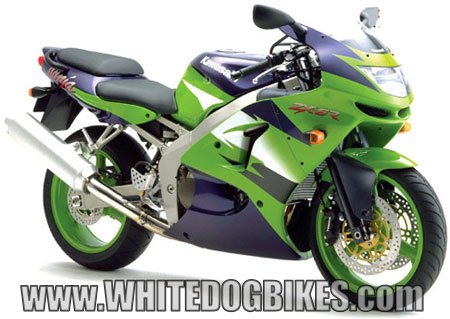
Kawasaki ZX6R Ninja Specs (G1/G2 models – 1998 to 2000)…..
The Kawasaki ZX6-R Ninja (G1 and G2 models) was a fully faired sports bike produced in the UK in the UK between 1998 and early 2000. The ZX-6R G was a major revamp of the previous ZX6R F Ninja model with increased BHP (up to 106 bhp from 100), new front forks, shorter wheelbase, 6kg lighter, digital dash readouts for the water temp, trip and clock and other modifications.
The ZX6R G model only ran for a few years and was replaced in 2000 by the ZX6R J Ninja
Servicing your bike? You’ll need a ZX6R workshop manual…
Basic model info… |
|
|---|---|
| Manufacturer: | Kawasaki |
| Model: | ZX6R G |
| CC: | 599cc |
| Engine type: | Inline 4 cylinder (4 stroke) |
| Years in production: | 1998 to 2000 |
| Kawasaki model code: | ZX600G |
| Style of bike: | Sports bike (fully faired) |
| Previous model: | ZX6R F Ninja |
| Replaced by: | ZX6R J Ninja |
| Insurance: | Group 14 (of 17) |
Looking for ZX6R Ninja parts? Buy ZX6R Ninja spares on Amazon…
A little bit about the Kawasaki ZX6-R G Ninja…
Models and years (in the UK) |
|
|---|---|
| ZX-6R Ninja G1 (March 1998 to October 1998)… | |
| Model: | ZX600-G1 |
| Frame number started: | |
| Description: | 599cc Sports bike updated from the previous ZX6R F model with new, 46mm cartridge style from forks, shorter wheelbase, revised steering geometry, bolt on rear subframe, uprated engine, carbs and airbox (producing a claimed 106bhp over the F models 100bhp), 6 piston front brake calipers, digital LCD displays for the mileometer, trip meter, water temperature and clock and a new rear fairing and rear light. |
| Available colours: | Ebony/grey, ebony/red and green/purple |
| Cost new: | £7250 (R and S reg models) |
| ZX-6R Ninja G2 (November 1998 to January 2000)… | |
| Model: | ZX600-G2 |
| Frame number started: | JKAZX600GGA024001—- |
| Description: | Same as above model but now has ZX6R logo on the belly pan. |
| Available colours: | Ebony/grey, red/grey and green/purple/grey |
| Cost new: | £5995 for an S or T reg model £6195 for a V reg model |
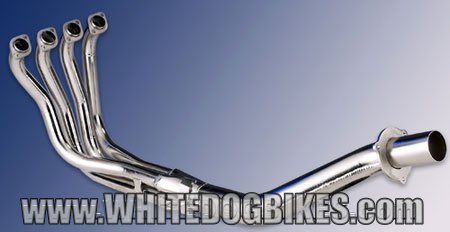
ZX6R G1/G2 Ninja aftermarket exhaust headers.
| Engine and gearbox stuff… | |
|---|---|
| Displacement: | 599 cc (36.55 cubic inches) |
| Engine type: | Inline four cylinder, four-stroke |
| Number of cylinders: | 4 |
| Cylinder firing order: | 1 – 2 – 4 – 3 |
| Compression ratio: | 11:8 |
| Bore and stroke: | 66.0 x 43.8mm |
| Cylinder compression: | 950 to 1450 kpa/td> |
| Power: | 108.00 HP (79.4 kw) @ 12000 RPM |
| Torque: | 65.7 Nm (6.7 kgf-m or 48 ft.lbs) @ 10000 RPM |
| 1/4 Mile time: | 10.9 seconds |
|
|
| Top speed: | 163 mph….Ish! (262.3 km/h) |
|
|
| Clearance between piston ring and cylinder bore: | 0.040mm (when new) to 0.072mm (max clearance) |
| Valves per cylinder: | 4 (16 valves in total) |
| Inlet valve clearance (with cold engine): | 0.11mm to 0.19mm |
| Exhaust valve clearance (with cold engine): | 0.22mm to 0.31mm |
| Cam shafts: | Double overhead cams (DOHC) |
| Fuel type: | Petrol (unleaded petrol – 95/4 grade, e.g. petrol from your local garage) |
| Engine oil capacity: | 3.6 litres |
| Oil pressure: | 1.2 to 1.8 bar |
| Oil system: | Forced lubrication (oil pump) from an oil sump with oil cooler |
| Recommended engine oil: | 10w40 Semi synthetic
|
| Engine oil filter capacity: | 0.2 litres |
| Oil filter: | Hiflo HF303 / Champion F306 |
| Oil change interval: | 5000km or 12 months |
| Cooling system: | Liquid cooled |
| Cooling system capacity: | 2.3 litres |
| Cooling system change interval: | Change every 30,000km or 24 months |
| Gearbox: | 6 speed (1st gear down, 2 to 6 gears up. Neutral between 1st and 2nd gear) |
| Clutch: | Wet, multi plate type clutch |
| Clutch part no: | EBC CK4503 (plates) and EBC CSK56 (springs) |
|
|
| Final drive stuff… | |
|---|---|
| Final drive: | chain |
| Chain length: | 108 links |
| Chain pitch: | 525 |
| Free play: | 35 to 45mm |
| Front sprocket: | 15 teeth |
| Rear sprocket: | 40 teeth |
| Fuel and carb stuff… | |
|---|---|
| Fuel type: | Petrol (unleaded petrol – 95/4 grade, e.g. petrol from your local garage) |
| Recommended fuel: | 4 stroke / 95 octane |
| Carb: | Mikuni BDSR 36R (x 4) |
| Idle speed: | 1300rpm (+/- 50rpm) |
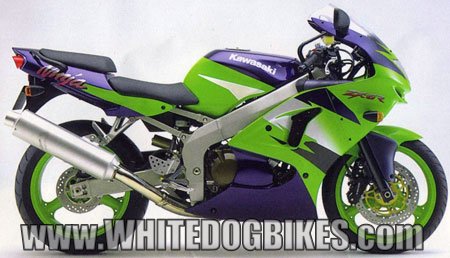
Kawasaki ZX6R G Ninja side view.
| Suspension, brakes and wheel stuff… | |
|---|---|
| Front brakes: | Twin (dual) 300mm discs |
| Front brake caliper: | Tokico 6 pot caliper |
| Front caliper bolt torque: | 34nm |
| Front disc part numbers: | EBC MD4136X (x2, left and right disc) |
| Front brake pad part number: | EBC FA188 |
| Upgrade front brake pad part number: | EBC EPFA188HH (sintered brake pads) |
|
|
| Rear brake: | Single 220mm disc |
| Rear brake caliper: | Tokico 1 (single) pot caliper |
| Rear caliper bolt torque: | 25nm |
| Rear disc part number: | EBC MD4138 |
| Rear brake pad part number: | EBC FA192 |
| Recommended brake fluid: | DOT 4 brake fluid |
| Brake fluid change interval: | Check every 5,000km and change every 20,000km or 24 months |
| Brake hose banjo bolt torque: | 25nm |
| Bleed nipple torque: | 7.8nm |
| Front wheel: | 3 Spoke cast |
| Front tyre size: | 120/60-17 |
| Front tyre pressure: | 36psi |
| Front spindle nut torque: | 110nm |
| Front spindle clamp bolt torque: | 20nm |
| Rear wheel: | 3 spoke cast |
| Rear tyre size: | 170/60-17 |
| Rear tyre pressure: | 41psi |
| Rear spindle nut torque: | 110nm |
| Front suspension: | 46mm Telescopic cartridge forks |
| |
| Stanchion diameter: | 46mm |
| Recommended fork oil: | Medium – 10w Fork oil |
| Fork oil capacity (oil change): | 500ml per fork |
| Fork oil capacity (if forks have been rebuilt and all old oil removed): | 588ml per fork |
| Fork oil change interval: | 30,000 km or 24 months |
| Rear suspension: | Single rear monoshock with adjustable preload, compression and rebound damping |
| Weights ‘n measures… | |
|---|---|
| Dry weight: | 176 kg (401.2 pounds) |
| Seat height: | 815mm |
| Wheelbase: | 1400mm |
| Length: | 2025mm |
| Width: | 715mm |
| Height: | 140mm |
| Min turning radius: | 3.2 meters |
| Fuel tank capacity: | 18 litres |
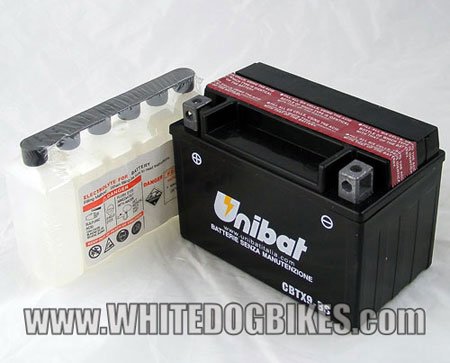
Kawasaki ZX6R G battery (YTX9-BS).
| Electrical stuff… | |
|---|---|
| Starter: | Electric starter motor |
| System voltage: | 12 volts |
| Max alternator output: | 22amps at 5000rpm |
| Regulated voltage: | 12.8 to 14.7 volts |
| Voltage regulated by: | Regulator/rectifier |
| Regulator/rectifier location: | On the right side of the bike (as your sitting on it), behind the frame, just above the top footpeg hanger bolt. |
| |
| Battery voltage capacity: | 12volts / 8amps |
| Battery: | YTX9-BS / CTX9-BS / DTX9-BS |
| |
| Ignition type: | Electronic IC Ignitor (similar to a CDI) |
| |
| Spark controlled by: | 2 x coil |
| Spark plug: | NGK CR9E / Denso U27ESR-N / Champion G59C |
| Spark plug gaps: | NGK 0.7 to 0.8mm / Denso 0.7 to 0.8mm / Champion 0.6mm |
| Ignition timing (BTDC): | 12.5 degrees at 1300rpm |
| Max ignition advance: | 35 degrees at 5000rpm |
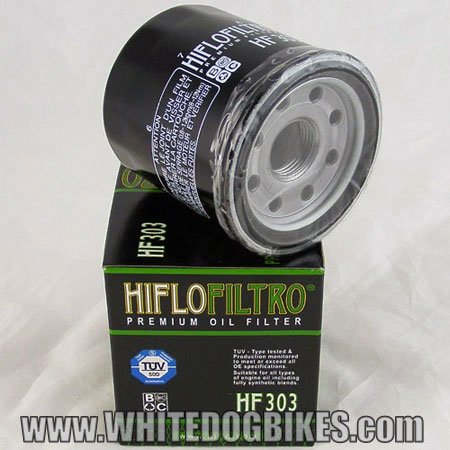
Kawasaki ZX6R G Ninja oil filter (Hiflo HF303).
| Servicing stuff… | |
|---|---|
| If your new to servicing or unsure, either ask a friend to help or get a ZX6R Ninja workshop manual… | |
| Engine oil change: | |
| Oil change interval: | 5000km (3107 miles) or 12 months |
| Engine oil capacity: | 3.6 litres |
| Engine oil filter capacity: | 0.2 litres |
| Recommended engine oil: | 10w40 Semi synthetic |
|
|
| Oil filter: | Hiflo HF303 / Champion F306 |
| Air filter: | |
| Air filter: | Kawasaki part no: 11013-1274 / Hiflo HFA2602 |
| Change interval: | 12000km (7456 miles) |
| Spark plugs: | |
| Spark plug: | 4 x NGK CR9E / Denso U27ESR-N / Champion G59C |
| Change interval: | 6000km (3728 miles) |
| Cooling system: | |
| Cooling system: | Liquid cooled |
| Cooling system capacity: | 2.3 litres |
| Cooling system change interval: | Change every 30,000km (18645 miles) or 24 months |
| Brake fluid: | |
| Recommended brake fluid: | DOT 4 brake fluid |
| Brake fluid change interval: | Check every 5,000km (3106 miles) and change every 24,000km (14912 miles) or 2 years |
| Front forks: | |
| Recommended fork oil: | Medium – 10w Fork oil |
| Fork oil capacity: | Oil change: 500ml (588ml if forks have been rebuilt and all old oil removed) |
| Front fork oil change interval: | 24,000km (14912 miles) or 2 years |
| Fork seals: | 46x58x9.5 |
| |
| Chain drive | |
| Final drive chain frequency: | Now repeat after me…..’I MUST LUBE MY CHAIN LITTLE AND OFTEN!!’ 🙂 |
| Useful tightening torques… | |
|---|---|
| Important torques | |
| Cylinder head (1st stage): | 20nm |
| Cylinder head (2nd stage): | 49nm |
| Cam cover: | 10nm |
| Magneto / flywheel: | 120nm |
| Crankshaft sprocket: | 125nm |
| Clutch hub: | 130nm |
| Spark plug: | 13nm |
| Front sprocket nut: | 125nm |
| Front wheel spindle: | 110nm |
| Front wheel spindle clamp (the ones in the fork leg): | 20nm |
| Rear wheel spindle: | 110nm |
| Oil torques | |
| Oil filter: | 10nm |
| Oil drain bolt: | 20nm |
| Oil pressure switch: | 15nm |
| Engine mounting point torques | |
| Engine mounting bolts and nuts: | 44nm |
| Engine mounting bracket bolts: | 23nm |
| Engine mounting clamp bolts: | 23nm |
| Cooling system torques | |
| Radiator fan switch: | 18nm |
| Water pump cover bolts: | 12nm |
| Engine torques | |
| Spark plugs: | 13nm |
| Cylinder head (1st stage): | 20nm |
| Cylinder head (2nd stage): | 49nm |
| Engine side cover bolts: | 12nm |
| Exhaust pipe connector bolts: | 34nm |
| Exhaust pipe clamp bolts: | 34nm |
| Oil pressure switch: | 15nm |
| Neutral switch: | 15nm |
| Wheel torques | |
| Front wheel spindle nut: | 110nm |
| Front wheel spindle clamp bolts (in the fork): | 20nm |
| Rear wheel spindle nut: | 110nm |
| Rear final/chain drive torques | |
| Front sprocket nut: | 125nm |
| Front sprocket cover bolts: | 12nm |
| Rear sprocket nuts: | 59nm |
| Brake torques | |
| Front caliper mounting bolts: | 34nm |
| Front brake disc bolts: | 23nm |
| Rear caliper mounting bolts: | 25m |
| Rear brake disc bolts: | 23nm |
| Suspension torques | |
| Front fork clamp bolts: | 20nm |
| Front fork bottom allen (drain) bolts: | 39nm |
| Rear shock absorber nuts: | 34nm |
| Swingarm pivot shaft nut: | 110nm |
| Frame torques | |
| Footpeg holder bolts: | 34nm |
| Side stand bracket bolts: | 49nm |
| Rear sub frame securing nuts and bolts: | 44nm |
| Electrical system torques | |
| Magneto / flywheel / alternator: | 120nm |
| Alternator cover bolts: | 12nm |
| Starter motor mounting bolts: | 11nm |
| |
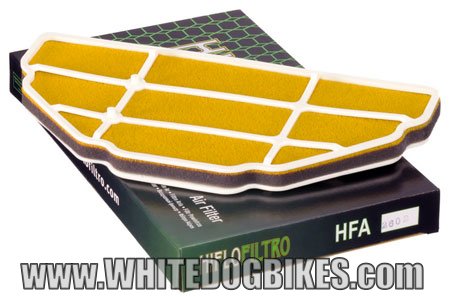
Kawasaki ZX6R G aftermarket air filter (Hiflo HFA2602).
Useless stuff…
Released in 1998, the ZX6R G1 is still considered a good bike, even by modern bike standards. Although not quite as quick as the Suzuki GSXR600 SRAD, it is alot easier to live with and doesn’t have you clutching your backside after 20 miles (although it can get a bit uncomfortable on very long distances). The bike is fairly rugged with not really any major faults and has a lovely howl through the airbox when ridden hard.
Buying advice…
Not really much to be wary of with these bikes. Obviously, stay away from ex racers and courier bikes. Not many couriers used them as they weren’t exactly a cheap hack, but there are alot of ex race bikes around (look for drilled nuts/sump bolts etc). Alloy parts do tend to pit and suffer if it’s been used in all weathers or left outside all year and electrics can be problematic if they get wet. These are older bikes now, so beware of rotten exhausts, pitted forks etc. However, there are loads of aftermarket parts for these bikes so most parts are plentiful and cheap on sites like eBay and Amazon.
Sources / Thanks to…
EBCBrakesDirect.com
ZX6R.com
for the service manual
Silkolene for the oil info
If you’ve got any questions or comments please feel free to leave them below 🙂
Disclaimer: The information on this page is correct to the best of our knowledge. But the info should NOT be taken as 100% accurate as we can, occasionally make mistakes!

Leave a Reply